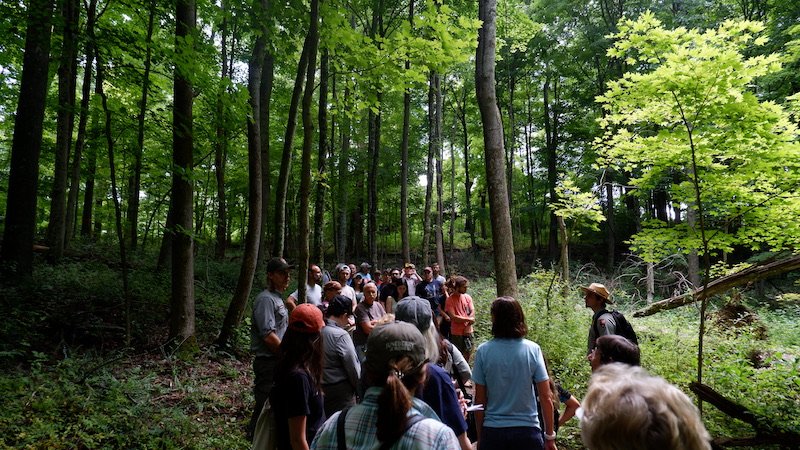New River Gorge’s Ancient Trees Withstood Timbering, Mining, and more!
By Mid-Atlantic Regional Manager, Brian Kane
When you visit the New River Gorge National Park and Preserve in West Virginia, steep, rocky mountain sides covered with trees are its prominent feature. The iconic and much photographed New River Gorge bridge straddles a deep ravine through which the New River flows. Looking down to the river far below, you can make out white water rafters in the New River that cuts through the national park. The river drops some 750 feet over 50 miles so it is extremely popular with white water rafters.
When you dive deep into the Park’s history you learn that the now lush hillsides were stripped to the bare earth first by logging, and then again when coal mining tore through mountains and railroads were constructed to transport coal back to major cities. Exhibits in the park’s Canyon Rim Visitors Center post old photos showing a denuded landscape that has slowly healed and recovered the steep hillsides again. A self-driving tour narrates drivers through the landscape, and the abandoned mining communities that developed in the early 1900s. It is hard to believe that few of the forests existed 100 years ago as the region was one of the nation’s top producing coal counties.
Remarkably, amidst the destruction and devastation a century ago, one stand of trees close to the park’s popular Canyon Rim Visitors’ Center withstood the mining and the timbering in the prior centuries. Thanks to the focus of a university professor and his student, the Burnwood Forest was researched, and documented. Many of the trees in this beech, black gum, hemlock and oak filled forest are over 125 years old, while a handful are over 360 years old. Concord University in Athens, West Virginia, in partnership with the National Park Service, confirmed that New River Gorge National Park & Preserve is home to one of these legacy forests that was spared from industrial logging.
Dr. Tom Saladyga, professor at nearby Concord University, taught NPS ranger Chance Raso in 2015 when he was a student there. When Raso, a native of the region, started working for the National Park Service at New River Gorge, something told him that the trees at Burnwood Forest were unusually mature and he called in his former advisor Dr. Saladyga to review it further. Summers of student inventory and research proved Raso correct, and the rest was history.
Today Raso gives tours of the forest, shares the beautiful old-growth areas, and is glad that the park now includes this feature in addition to the many other hiking, rafting, and explorations afforded at New River Gorge. A readily navigated trail leads visitors through a 1.2 mile loop to explore the wonder of a forest that has persisted against the odds. The 350 year old black gum is a true highlight and takes one’s breath away!
Curious about how you can help out at the Old-Growth Forest Network? Sign up to become a County Coordinator today and learn more about how you can make an impact with the old-growth forests in your area!






